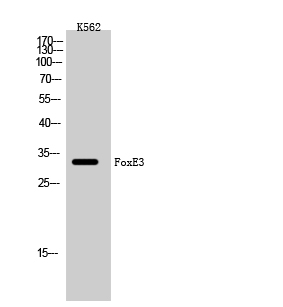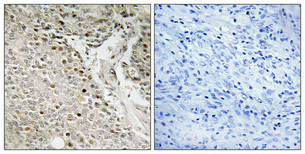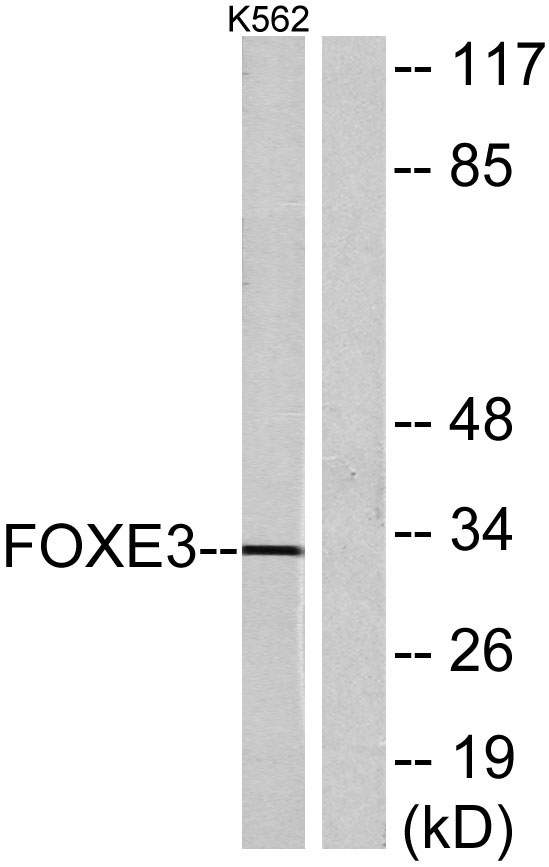FoxE3 Polyclonal Antibody
- Catalog No.:YT1749
- Applications:WB;IHC;IF;ELISA
- Reactivity:Human;Mouse;Rat
- Target:
- FoxE3
- Gene Name:
- FOXE3
- Protein Name:
- Forkhead box protein E3
- Human Gene Id:
- 2301
- Human Swiss Prot No:
- Q13461
- Mouse Gene Id:
- 30923
- Mouse Swiss Prot No:
- Q9QY14
- Rat Swiss Prot No:
- Q63250
- Immunogen:
- The antiserum was produced against synthesized peptide derived from human FOXE3. AA range:81-130
- Specificity:
- FoxE3 Polyclonal Antibody detects endogenous levels of FoxE3 protein.
- Formulation:
- Liquid in PBS containing 50% glycerol, 0.5% BSA and 0.02% sodium azide.
- Source:
- Polyclonal, Rabbit,IgG
- Dilution:
- WB 1:500 - 1:2000. IHC 1:100 - 1:300. ELISA: 1:20000.. IF 1:50-200
- Purification:
- The antibody was affinity-purified from rabbit antiserum by affinity-chromatography using epitope-specific immunogen.
- Concentration:
- 1 mg/ml
- Storage Stability:
- -15°C to -25°C/1 year(Do not lower than -25°C)
- Other Name:
- FOXE3;FKHL12;FREAC8;Forkhead box protein E3;Forkhead-related protein FKHL12;Forkhead-related transcription factor 8;FREAC-8
- Observed Band(KD):
- 33kD
- Background:
- This intronless gene belongs to the forkhead family of transcription factors, which is characterized by a distinct forkhead domain. The protein encoded functions as a lens-specific transcription factor and plays an important role in vertebrate lens formation. Mutations in this gene are associated with anterior segment mesenchymal dysgenesis and congenital primary aphakia. [provided by RefSeq, Dec 2009],
- Function:
- disease:Defects in FOXE3 are a cause of anterior segment mesenchymal dysgenesis (ASMD) [MIM:107250]; also known as anterior segment ocular dysgenesis (ASOD). ASMD includes all malformations involving the first (corneal endothelium and trabecular meshwork), second (corneal stroma) and third (iris stroma) mesenchymal waves of neural crest. The ASMD phenotype is characterized by corneal opacities with or without iris adhesions in 100%, cataracts of varying severity in 100% and optic-nerve abnormalities in 20% of affected individuals.,disease:Defects in FOXE3 are a cause of congenital primary aphakia (CPA) [MIM:610256]. Human aphakia is a rare congenital eye disorder in which the lens is missing. It has been histologically subdivided into primary and secondary forms, in accordance with the severity of defects of the ocular tissues, whose development requires the initial presence of a lens. C
- Subcellular Location:
- Nucleus .
- June 19-2018
- WESTERN IMMUNOBLOTTING PROTOCOL
- June 19-2018
- IMMUNOHISTOCHEMISTRY-PARAFFIN PROTOCOL
- June 19-2018
- IMMUNOFLUORESCENCE PROTOCOL
- September 08-2020
- FLOW-CYTOMEYRT-PROTOCOL
- May 20-2022
- Cell-Based ELISA│解您多样本WB检测之困扰
- July 13-2018
- CELL-BASED-ELISA-PROTOCOL-FOR-ACETYL-PROTEIN
- July 13-2018
- CELL-BASED-ELISA-PROTOCOL-FOR-PHOSPHO-PROTEIN
- July 13-2018
- Antibody-FAQs
- Products Images

- Western Blot analysis of K562 cells using FoxE3 Polyclonal Antibody cells nucleus extracted by Minute TM Cytoplasmic and Nuclear Fractionation kit (SC-003,Inventbiotech,MN,USA).

- Immunohistochemical analysis of paraffin-embedded Human prostate cancer. Antibody was diluted at 1:100(4° overnight). High-pressure and temperature Tris-EDTA,pH8.0 was used for antigen retrieval. Negetive contrl (right) obtaned from antibody was pre-absorbed by immunogen peptide.

- Western blot analysis of lysates from K562 cells, using FOXE3 Antibody. The lane on the right is blocked with the synthesized peptide.



